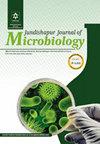伊朗德黑兰Shahid Rajaei医院临床样本中分离的产blaOXA-48和blaNDM的碳青霉烯耐药性肺炎克雷伯菌的高患病率
IF 0.5
4区 医学
Q4 MICROBIOLOGY
引用次数: 3
摘要
背景:由于抗生素耐药性的增加,治疗肺炎克雷伯菌引起的感染变得更具挑战性。目的:本研究旨在调查从伊朗德黑兰Shahid Rajaei医院的临床样本中分离出的blaOXA-48和产生blaNDM的碳青霉烯耐药性肺炎克雷伯菌的流行率。方法:从伊朗德黑兰Shahid Rajaei心脏病医院两个病房(ICU和外科)接受心脏直视手术的1186名患者中收集各种临床样本。肺炎克雷伯菌分离株通过标准微生物试验鉴定。采用纸片扩散法和E试验法测定分离株的耐药性。采用改良的碳青霉烯失活法(mCIM)检测碳青霉烯酶的存在。使用常规聚合酶链式反应(PCR)通过靶向blaOXA-48、blaSPM、blaIMP、blaVIM和blaNDM基因的引物检测抗生素抗性基因。结果:共分离到131株肺炎克雷伯菌,其中45.8%(60/131)对碳青霉烯耐药。肺炎克雷伯菌对头孢曲松、头孢他啶、头孢唑林和头孢吡肟的耐药率最高(100%),对替加环素的敏感性最高(96.7%)。编码blaOXA-48和blaNDM-1基因的碳青霉烯酶分别在96.7%和66.7%的分离株中检测到。考虑到≥80%的同源性截断,八个不同的分离株簇显示出相同的rep PCR模式。簇A、B、C、D、E、F、G和H分别包括20、11、7、6、6、3、2和2个成员。结论:RAPD-PCR方法揭示了分离株之间的克隆关系,可能有助于改进感染控制程序。本文章由计算机程序翻译,如有差异,请以英文原文为准。
High Prevalence of blaOXA-48 and blaNDM-Producing Carbapenem-Resistant Klebsiella pneumoniae Isolated from Clinical Samples in Shahid Rajaei Hospital in Tehran, Iran
Background: Due to the increasing antibiotic resistance, treating infections caused by Klebsiella pneumoniae has become more challenging. Objectives: The present study aimed to investigate the prevalence of blaOXA-48 and blaNDM producing carbapenem-resistant K. pneumoniae isolated from clinical samples in Shahid Rajaei hospital in Tehran, Iran. Methods: Various clinical samples were collected from 1,186 patients admitted with open heart surgery in two wards (ICU and surgery) in Shahid Rajaei Heart Hospital in Tehran, Iran. Klebsiella pneumoniae isolates were identified by standard microbiologic tests. Antimicrobial susceptibility of isolates were determined by disk diffusion and E-test methods. A modified carbapenem inactivation method (mCIM) was performed to detect the presence of carbapenemase. Antibiotic resistance genes were detected using conventional polymerase chain reaction (PCR) by primers targeting blaOXA-48, blaSPM, blaIMP, blaVIM, and blaNDM genes. Results: A total of 131 clinical isolates of K. pneumoniae were isolated and 45.8% (60/131) of them were resistant to carbapenem. Klebsiella pneumoniae isolates showed the highest resistance rate (100%) to ceftriaxone, ceftazidime, cefazolin, and cefepime and the maximum sensitivity to tigecycline (96.7%). The carbapenemase-encoding blaOXA-48 and blaNDM-1 genes were detected in 96.7% and 66.7% of isolates, respectively. Eight different clusters of the isolates, considering a ≥ 80% homology cut-off, were shown with the same rep-PCR pattern. Clusters A, B, C, D, E, F, G, and H included 20, 11, 7, 6, 6, 3, 2, and 2 members, respectively. Conclusions: The RAPD-PCR method reveals the clonal relationship between isolates and may help improve infection control procedures.
求助全文
通过发布文献求助,成功后即可免费获取论文全文。
去求助
来源期刊

Jundishapur Journal of Microbiology
MICROBIOLOGY-
CiteScore
1.30
自引率
0.00%
发文量
56
审稿时长
6-12 weeks
期刊介绍:
Jundishapur Journal of Microbiology, (JJM) is the official scientific Monthly publication of Ahvaz Jundishapur University of Medical Sciences. JJM is dedicated to the publication of manuscripts on topics concerning all aspects of microbiology. The topics include medical, veterinary and environmental microbiology, molecular investigations and infectious diseases. Aspects of immunology and epidemiology of infectious diseases are also considered.
 求助内容:
求助内容: 应助结果提醒方式:
应助结果提醒方式:


